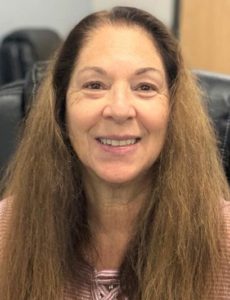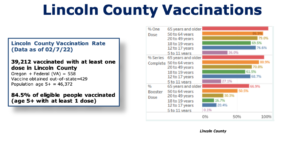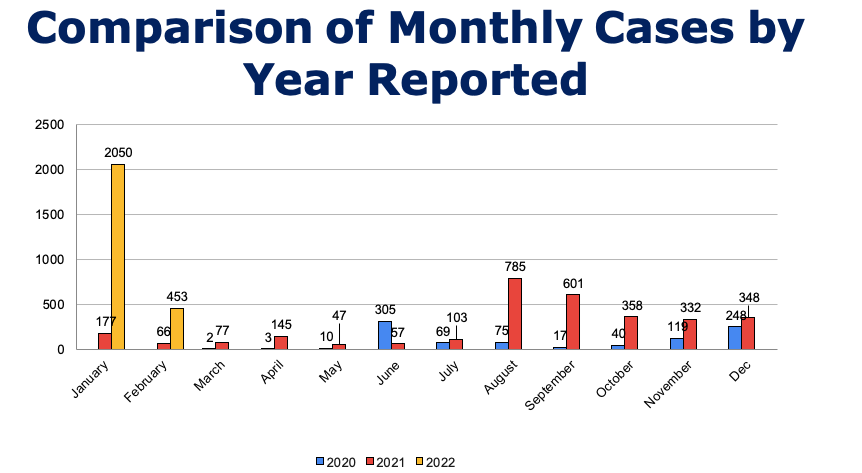
By YachatsNews.com and Oregon Capital Chronicle
Schools in Oregon will be out from under a state mandate at the end of March that requires students, staff and visitors to wear masks.
But just how mask protocols might change in the Lincoln County School District and for its 5,000 students and 600 staff is a long way from being decided, Superintendent Karen Gray told the school board Tuesday night.
The Oregon Health Authority this week announced that the state will end mask requirements for indoor activities when the daily statewide hospitalization rate drops below 400 – or March 31, whichever comes first. There were just under 1,000 people hospitalized in Oregon with Covid-19 on Wednesday, a 30 percent increase from the previous week, but just four as of Monday in Lincoln County.
But the OHA’s decision on schools is different. It will drop the mask requirement for schools on March 31 – but no earlier. That’s two days after most students and staff return from Spring Break.
But schools – in consultation with their county health departments – can continue a mask mandate on their own or make them optional. The state’s decision, however, does not affect a federal requirement that students and staff where masks on school buses.

Gray told the board that the district will initiate “conversations with lots of different groups,” including parents, staff and their unions, volunteers and the public. District administrators will also look closely at Covid-19 and hospitalization rates and consult with Lincoln County Public Health.
“It is no secret that local public health has been very conservative,” Gray told the board.
The number of reported Covid-19 cases in Lincoln County skyrocketed to more than 2,000 in January as the omicron variant swept the state. And while there have been more than 450 cases reported in February, the daily rate has dropped from near 100 to about 50.

Cases in Lincoln County peaked the week of Jan. 16, LCPH director Florence Pourtal told county commissioners this week. “We’re seeing a trend down …” she said, but the rate is still very high compared to any month in 2020 and 2021.
Lincoln County has one of the highest overall vaccination rates in Oregon. Nearly 69 percent of children age 12-17 are fully vaccinated, but only 20 percent have gotten a booster dose, according to the county. Just 27 percent of children age 5-11 in the county are vaccinated.
Gray told her board Tuesday that what the school district does will ultimately be decided by district administrators and the board.
“We are going to make safety our No. 1 priority,” she said. “But we are nowhere close to making a decision.”

Different approaches, different issues
Jon Zwemke, superintendent of schools in the coastal town of Reedsport, got just a few hours’ notice that statewide mask mandates would be over for his students and staff by the end of March. “That allowed me to put together a Facebook post and a website statement to say ‘We’ll have better communication by Friday,’” Zwemke told the Oregon Capital Chronicle.
He and other superintendents across the state will now have to decide how to keep students safe if they forgo one of the key Covid prevention protocols – while avoiding backlash from parents and staff.
Zwemke said he gets the strong sense that people in his community are tired of masks and they’ll welcome the opportunity to make them an option rather than a requirement. Still, “In my seat it’s a lot easier when we’re told to do it in a certain way,” he said.
Zwemke suspects board members will decide to make masks optional after March 31.
Districts that choose to make masks optional will have to come up with new plans to avoid an outbreak of the virus among students while also doing whatever they can to keep students in school.
They’ll no longer have access to the test-to-stay program that had allowed unvaccinated students to stay in school even after an exposure as long as they test negative three to five days later. Without a mask requirement in schools, unvaccinated students will need to quarantine immediately after an exposure, according to the new guidance from the state Health Authority.
“Universal masking is a key measure to prevent the spread of Covid-19. In its absence, schools should anticipate significant increases in workload from contact tracing and notification,” warned Colt Gill, director of the state Education Department, in a note to school officials.
The agency is recommending that schools continue masking mandates after March 31.
The Capital Chronicle emailed 154 school superintendents on Monday about the new masking rules, and heard back from 37 by mid-afternoon. Most expressed a level of relief that a future where students didn’t have to be masked was nearing, while some expressed concerns that maintaining student health would now be an even greater responsibility for them than before.
Of the superintendents that responded to questions, 25 superintendents said they’d wait to take the matter to their school boards and use the next seven weeks to gather more feedback from parents, students, staff, school employee unions and local health officials before recommending whether to make masks optional or keep them mandatory.
Among the responses, eight district superintendents said they would be making masks optional for students and staff after March 31.
Reed Scott-Schwalbach, president of the Oregon Education Association, the state’s largest teachers union, wrote in an email that, “While the science is clear that wearing masks indoors helps reduce the transmission of Covid-19, opinions on mandatory masks in schools vary greatly from community to community and from school to school … It will be more important than ever for district leaders throughout the state to meaningfully engage with educators and with the communities they serve.”
Mary Paulson, deputy director at the Oregon School Boards Association, said in an email that the association strongly supports local control, but members will be advised to carefully consider the liabilities that come with making masks optional.
The association helped to get House Bill 4402 passed in 2020, which provided school districts and charter schools with limited protection for Covid-related claims. But for schools to be protected against such claims, they must comply with all Covid-19 emergency rules, including guidance from the state Education Department and Health Authority.
“Schools should consult with their local health authorities, school nurses, risk managers, attorneys and any other applicable stakeholders regarding safety and liability concerns,” Paulson wrote.
In Umatilla, Superintendent Heidi Sipe said they’re prepared to go mask optional after March 31.
The district had already prepared such a policy last August, right before the 2021-22 school year started and the statewide indoor mask mandate was applied to everyone 5 years and older in schools.
“We did a release and made a video for parents all about how mask optional would work in our district,” she said, “then the statewide mask mandate came out the next day.”
The district’s policy for optional masking includes new seating protocols in classes. Students who are masked sit together and students who are unmasked sit together. If the teacher leading a class chooses to be unmasked, then unmasked students sit to the front and masked students sit to the back. If the teacher chooses to be masked, then masked students sit to the front.
If a student decides not to wear a mask one day, then to wear a mask the next, they must still sit with the maskless students for a week until they can sit with the masked students. Sipe said every classroom in the district has a portable, medical-grade air purifier that will be set between the two groups of students.
She said these steps are intended to ensure masked students won’t have to quarantine if an outbreak occurs in a class, while unmasked students will.
Sipe said in many of the after-school sports where masks have been optional, students have started wearing them again because they don’t want to be quarantined if there’s an exposure.
“They understand the risks and they’re really pretty savvy about deciding what’s best for them, especially the high schoolers,” she said.
Sipe said if school officials see a spike in cases, they’ll ask people to wear masks again for a time. For now, she updates the district site weekly with the number of student cases in each grade level and school.
“That gives parents the opportunity to make decisions,” she said, about whether to send their kids to school, or to send them with a mask, given case numbers.
- Reporting by Quinton Smith of YachatsNews and Alex Baumhardt of Oregon Capital Chronicle



Whole countries are dropping or have already dropped all mandates. This isn’t about safety. It’s about the all mighty dollar and control. Enough is enough! Hate to break Karen Gray’s bubble but she works for us and not the other way around. She needs to focus on getting these kids educated and Lincoln County schools in top shape to do so. Oregon and Oregon public schools have gotten millions and millions of tax payer dollars and now it’s time to start seeing some results instead of the constant downward slide of this state’s public schools which should be flush with cash from Lottery dollars, cannabis taxes, fee’s and permits and some of the highest property taxes in the nation. Someone needs to investigate where all these dollars have gone. If there were any real journalist left they would. Why with all this cash floating around are our kids getting way below par lunches served to them? Where are all these award winning music programs that the superintendent got an award for? What was the criteria for that? Our children are being ripped off, our elderly are being ripped off by having to pay high property taxes to fund these poor performing schools and every single mother busting her tail is being ripped off as are the other working taxpayers. Want to do something amazing as a journalist or media company? Do some open, honest, down and dirty investigation of the mismanagement, waste and failure of Oregon public schools. Where is the money? Where are the failures? How do we fix it? How do we keep it from happening again? Let’s see some numbers. Let’s see some transparency in easy to follow along terms. Can you imagine what we could actually do with all that money to improve our schools to make real progress? Every Oregon School should be top notch with all the latest technology. That is far from what we have. The money is there — or at least it should be.